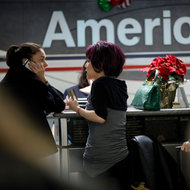The stock market eked out small gains on Tuesday after an upturn in technology companies offset weakness in other parts of the market, including a drop in airline shares.
The gain in technology stocks was driven by Apple, which surged $22.21, or 4.8 percent, to $489.57 after the billionaire investor Carl C. Icahn posted on Twitter that he held a large position in the company and that its stock was undervalued.
August has begun as a lackluster month for the stock market as major indexes fail to add significantly to gains made in July. The Standard Poor’s 500-stock index has drifted lower since closing at a nominal high on Aug. 2. Still, the index is up 18.8 percent this year.
On Tuesday, the S. P. 500 rose 4.69 points, or 0.3 percent, to close at 1,694.16. The Nasdaq composite index gained 14.49 points, or 0.4 percent, to 3,684.44. The Dow Jones industrial average rose 31.33 points, or 0.2 percent, to 15,451.01.
A sharp rise in Treasury yields rippled through the stock market on Tuesday. The yield on the 10-year note climbed almost to its highest point in two years after an increase in July retail sales added to speculation that the Federal Reserve will begin to wind down its economic stimulus program sooner rather than later.
The president of the Federal Reserve Bank of Atlanta, Dennis P. Lockhart, said on Tuesday that it was too early to say when the bank would reduce its stimulus, but hinted that it probably would happen this year.
“You could argue that stocks would be up higher today if the bond market was behaving,” said John Canally, an investment strategist for LPL Financial. “The market’s trend right now is higher.”
Airline stocks slumped after the federal government challenged the proposed merger of US Airways and American Airlines, which is seeking to leave bankruptcy.
The Justice Department, which filed an antitrust lawsuit to block the merger of the airlines, which are among the nation’s largest, said the deal would substantially reduce competition, increase fares and curtail service. US Airways plunged $2.46, or 13.1 percent, to $16.36.
Among the stocks on the move, J. C. Penney fell 49 cents, or 3.7 percent, to $12.68. The struggling department store chain faces uncertainty after the activist investor William A. Ackman resigned from its board.
In government bond trading, the price of the 10-year Treasury note fell 27/32, to 98 3/32, while its yield jumped to 2.72 percent from 2.62 percent late Monday.

Article source: http://www.nytimes.com/2013/08/14/business/daily-stock-market-activity.html?partner=rss&emc=rss





